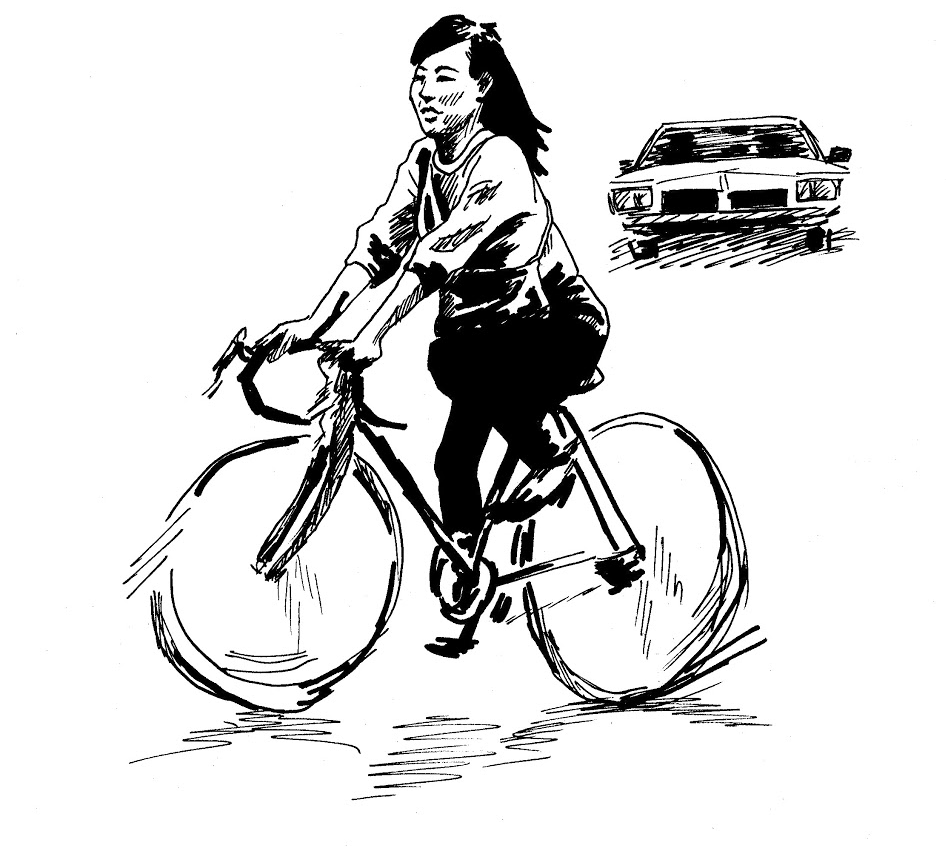
Between the crinkle of fallen leaves under tires and flannels flapping in the breeze, there’s something iconic about the fall semester bike ride. Students zip from Old Campus to Science Hill in a matter of minutes, relishing a swiftness we’ll have to give up when the streets are slick with ice. For this eight-week window, we can glide down Elm St., inhaling the crisp scent of fall. But there’s something missing when you imagine this idyllic scene: a helmet.
 For how many bikers there are in the Yale community, there are puzzlingly few helmets. In a thoroughly anecdotal study I conducted while walking from SSS to WLH earlier today, I witnessed a dozen bikers — all of whom had their hair in the wind. As a community, we pride our dedication to rational thought and often justify our ungallant romantic and professional decisions with our deep-seated risk aversion. Yet in this regard we seem to reserve rational thought for writing our papers and risk aversion in attending a McKinsey recruiting event. Few of us can bear to shell out $13 for an oblong monstrosity, and fewer still are willing to wear a helmet even if we reluctantly decided to buy one. When we bike, Yalies often leave our better judgment behind like the pedestrians we pass. No one here wants to look like an egghead. Even our campus’ hippest hipsters would struggle to don a helmet ironically.
For how many bikers there are in the Yale community, there are puzzlingly few helmets. In a thoroughly anecdotal study I conducted while walking from SSS to WLH earlier today, I witnessed a dozen bikers — all of whom had their hair in the wind. As a community, we pride our dedication to rational thought and often justify our ungallant romantic and professional decisions with our deep-seated risk aversion. Yet in this regard we seem to reserve rational thought for writing our papers and risk aversion in attending a McKinsey recruiting event. Few of us can bear to shell out $13 for an oblong monstrosity, and fewer still are willing to wear a helmet even if we reluctantly decided to buy one. When we bike, Yalies often leave our better judgment behind like the pedestrians we pass. No one here wants to look like an egghead. Even our campus’ hippest hipsters would struggle to don a helmet ironically.
To be sure, helmetless biking is not a public health priority. As I have written before, STI testing, cigarette use and sexual violence all represent bigger and badder epidemiological fish for Yale to fry. Still, wearing a helmet keeps you safe. According to a 2007 study published in the journal “Injury Prevention,” wearing helmets provide a 63 to 88 percent reduction in head and brain injury for all cyclists. But we don’t need statistics to know that.
The choice of our community members to bike without helmets is worth lingering over because it illustrates a collision of Yale values: our risk aversion with our sense of invulnerability, our rationality with our image anxiety. Many Yalies sacrifice safety for aesthetic.
This is hardly surprising. Millennials have grown up in an era in which public image pressure is inescapable. The cultivation and curation of our virtual selves can feel paramount. Between Facebook, Instagram, Twitter and Tinder, we wrangle with the expectation to present our lives through a filter. This anxiety takes on an amplified form at Yale, where the desire to project that we are “doing great” is as common as a social event where the dress code is formal. The Ivy League’s obsession with excellence is as deep-seated as its obsession with elegance.
This pressure is hard to resist. At a school where we convince ourselves to forgo staples of wellness like sleep or asking for help, why would we need a helmet? Our reflexes are fast, and our hair could use a little wind-sweeping before seminar. We have been told that our futures are bright and our brains are powerful so many times that we forget that a skull can only withstand so much physical force.
The members of the Yale community who bike without a helmet are not oblivious to the risk that they take on. The body of data related to concussions and traumatic brain injuries is hard to ignore. Just three days ago, Kenney Bui, a high-school football player from Washington, died after sustaining a head injury midgame even when he was wearing a helmet. I cannot recall a single bike injury death in the Yale community during the nearly five years I’ve been in New Haven, but every time I see one of my classmates hurtling down Science Hill with little more than seven millimeters of bone between their brain and the asphalt, I can’t help but think they’re tempting fate. Two of my friends had to take a semester of medical leave from Yale after their traumatic brain injuries. And while these weren’t bike accidents, the consequences were the same. “The risk of brain injury [only feels] real only after it’s happened,” one of them told me yesterday afternoon. “But that’s true of everything.”
For the majority of people at Yale, the risk of brain injury is abstract, whereas social anxiety is immediate and inescapable. In our collegiate estimation of stakes, headgear seems like a greater risk than head injury. In a warped sort of way this makes sense. In a community where studied carelessness is the norm, helmets are careful to the point of gawkiness.
Then again, I struggle to think that anything — any friendship, party invitation, date, one-night-stand, relationship, election, promotion, recommendation or induction — ever hinged on the decision to look silly and safe and wear a helmet.
Nathan Kohrman is a senior in Saybrook College. His column runs on alternate Thursdays. Contact him at nathan.kohrman@yale.edu .







